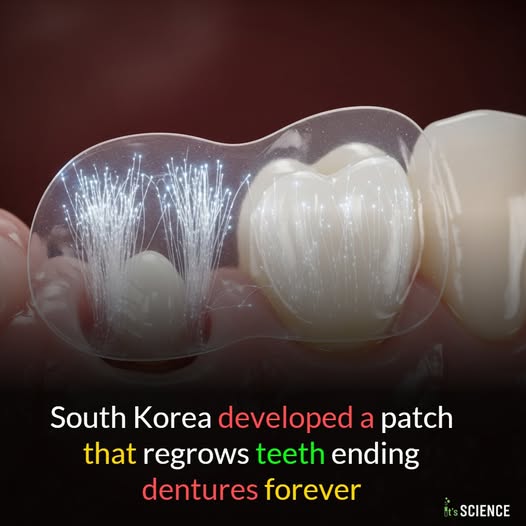We Bring Back the Sparkle in Your Smile.
South Korea’s Tooth-Regenerating Patch and AI in Dentistry: What Filipinos Need to Know
Language :

Topics:
New technologies — from AI diagnostics to regenerative medicine — are reshaping dentistry. A promising breakthrough from researchers in South Korea reports a microneedle patch that can stimulate tooth stem cells to regenerate enamel and even form new tooth buds. For Filipino patients, this raises hope: less drilling, fewer implants, and more biological solutions. But before we celebrate, a dose of critical thinking is needed.
Source: Seoul National University School of Dentistry; Science Translational Medicine (study on tideglusib microneedle patch).
What the research says (briefly)
-
The patch delivers a drug (tideglusib) plus growth factors via painless microneedles applied to the gum for ~20 minutes daily.
-
Reported clinical-trial findings: small cavities healed in 4–6 weeks; enamel regrowth in ~8 weeks for some chipped teeth; ~30% of participants showed de novo tooth bud formation.
-
Claimed benefits: no drilling, no fillings, low pain, and regenerated tissue is genetically the patient’s own (so low rejection risk).
-
Commercialization plans were reported, with projected cost estimates (~US$300 per tooth in early commercialization).
Why this could matter for the Philippines
-
Cost reduction potential: If validated and scaled, regenerative patches could be much cheaper than implants/dentures (which cost thousands).
-
Access & prevention: Less invasive treatments could encourage Filipinos who delay dental care (often for financial reasons) to seek early help.
-
Dental tourism & local practice: New tech can attract investment and training — improving local dental services over time.
-
Younger generations: AI tools and regenerative methods may offer better preventive care and more conservative treatments for future generations.
AI and other dental innovations changing the field now
-
AI diagnostics: Faster, more accurate detection of caries, fractures, and periodontal disease from X-rays and intraoral photos.
-
3D printing & CAD/CAM: Faster crowns, surgical guides, and dentures with better fit and lower cost.
-
Minimally invasive therapies: Biologics, local drug delivery, and adhesive restorations that preserve tooth structure.
-
Teledentistry: Remote consultations and triage that expand access in rural areas.
Critical thinking: limitations & unanswered questions
Before you book a regenerative patch, consider these important points:
-
Scale & sample size: Early clinical trials can be small. Results that look great in a pilot may change in larger trials.
-
Long-term outcomes: We need multi-year follow-up to know whether regenerated enamel is durable and whether new tooth buds develop into fully functional teeth.
-
Regulatory approval: Clinical trials don’t equal regulatory clearance. Check which health agencies (e.g., FDA-equivalents) have approved the treatment for public use.
-
Side effects & safety: Local drug delivery and stem-cell activation could have unforeseen local or systemic effects that require monitoring.
-
Cost & access: Early commercialization pricing and distribution will determine whether the tech benefits urban centers only or reaches provincial and rural patients.
-
Not a silver bullet: Some problems (advanced infection, severe bone loss, systemic conditions) will still require conventional surgery, implants, or multidisciplinary care.
-
Quality control & counterfeit risk: New high-demand products can spawn poor-quality or fake versions — verify supplier and clinic credentials.
Practical advice for Filipino patients (what you should do now)
-
Don’t delay care. Even if regenerative tech becomes available, prevention is still cheaper and safer than waiting for advanced treatment.
-
Ask questions: If a clinic offers a new therapy, ask about trial data, approvals, long-term results, and possible risks.
-
Verify credentials: Only get novel treatments from accredited clinics and licensed dental specialists.
-
Keep up with basics: Brush twice daily, floss, reduce frequent sugary/acidic snacks, and attend regular cleanings — these remain the foundation of oral health.
-
Watch out for claims: Be skeptical of clinics promising immediate “tooth regrowth” without documentation. Ask for peer-reviewed studies and regulatory approvals.
-
Use trusted directories: Find licensed dentists near you (for example, use local professional directories or verified listings such as your regional dental association).
-
Plan financially: If you’re concerned about cost, ask clinics about installment plans, public clinics, or community dental programs.
How this could play out in the next 5 years (reasonable outlook)
-
Short term: More clinical trials, pilot commercial rollouts in select countries, and refined application protocols.
-
Medium term: Wider availability if regulatory approvals and cost models succeed — but adoption will vary by country and healthcare infrastructure.
-
Long term: Integration with AI diagnostics and personalized treatment plans that combine prevention, regenerative therapy, and minimally invasive restorations.
Conclusion
The tideglusib microneedle patch is an exciting example of how regenerative medicine and newer delivery systems could transform dentistry. Combined with AI and digital workflows, the future promises less invasive, more personalized care. However, Filipinos should balance optimism with caution: verify evidence, follow regulatory guidance, and continue routine preventive care. Technology is powerful — but smart, informed patients and licensed professionals must guide its use.




